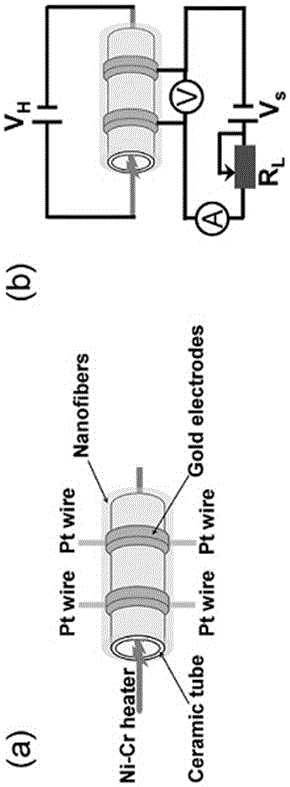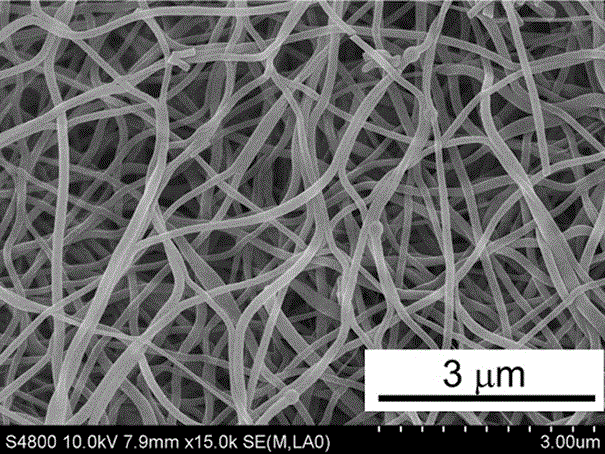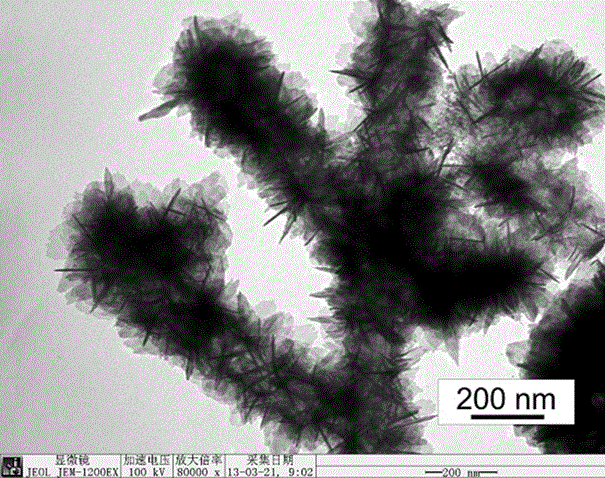A nanofiber coupling structure gas-sensing material and its preparation method and application
A gas-sensitive material and nanofiber technology, applied in nanotechnology, nanotechnology, material resistance, etc., can solve the problems of long response recovery time, poor selectivity, low sensitivity, etc., and achieve simple and convenient production equipment, improved sensitivity, and preparation technology. simple effect
- Summary
- Abstract
- Description
- Claims
- Application Information
AI Technical Summary
Problems solved by technology
Method used
Image
Examples
Embodiment 1
[0051] In a 50 mL Erlenmeyer flask, add 0.7 g polyacrylonitrile (PAN) to 9.3 mL N,N~dimethylformamide (DMF), stir at 60°C for 8 h until the solution is completely clear, and cool to room temperature.
[0052] Put the dissolved PAN solution into the spinneret of the electrospinning equipment, the inner diameter of the spinneret head is 1 mm, the aluminum sleeve is used as the anode, and the aluminum foil is used as the cathode plate to receive the product. The distance between the two electrodes is 20 cm. The voltage is 15 kV for electrospinning. In this way, polyacrylonitrile nanofibers are obtained on the cathode receiving plate.
[0053] The PAN nanofibers were placed in the air for 20 hours to allow the residual solvent in the fibers to volatilize, and then placed in a tubular electric furnace, heated to 250°C at a rate of 5°C / min, and pre-oxidized in air for 2 hours. Pour nitrogen into the tube furnace, heat up to 289°C at a rate of 1°C / min, and stabilize for 30 minutes; conti...
Embodiment 2
[0060] The solution preparation, spinning process, and carbon fiber sintering process are the same as in Example 1.
[0061] Take a 100 mL beaker, add 40 mL of 10 mM thioglycolic acid solution, weigh 6 mg of carbon nanofibers into the beaker, and sonicate for 1 hour to make the carbon fibers uniformly dispersed in the solution. Then add 0.1 g SnCl to the beaker 2 , 0.5 mL 37% HCl solution, 0.5 g urea, stir for 10 min. The mixed solution was transferred to a 60 mL hydrothermal reactor, and placed in a constant temperature oven at 120°C for 12 hours, the reaction solution was taken out, and the precipitate was separated, washed, and dried.
[0062] The assembly process of the gas sensor is the same as in Example 1. The optimal operating temperature of the device is still 200°C, and the response value to 100 ppm hydrogen is 7.2 at this temperature.
[0063] Such as Figure 4 As shown, the SnO prepared in Example 2 2 The transmission photo of the carbon nanofiber coupling structure. It...
Embodiment 3
[0065] The solution preparation, spinning process, and carbon fiber sintering process are the same as in Example 1.
[0066] Take a 100 mL beaker, add 40 mL of 10 mM thioglycolic acid solution, weigh 6 mg of carbon nanofibers into the beaker, and sonicate for 1 hour to make the carbon fibers uniformly dispersed in the solution. Then add 0.1 g SnCl to the beaker 2 , 0.5 mL 37% HCl solution, 0.5 g urea, stir for 10 min. The mixed solution was transferred to a 60 mL hydrothermal reactor, and placed in a constant temperature oven at 120°C for 6 hours, the reaction solution was taken out, and the precipitate was separated, washed, and dried.
[0067] The assembly process of the gas sensor is the same as in Example 1. The optimal operating temperature of the device is still 200°C, and the response value to 100 ppm hydrogen is 4.2 at this temperature.
[0068] Such as Figure 5 As shown, the SnO prepared in Example 3 2 / Carbon nanofiber coupling structure. It can be seen that there is SnO...
PUM
| Property | Measurement | Unit |
|---|---|---|
| diameter | aaaaa | aaaaa |
| diameter | aaaaa | aaaaa |
| diameter | aaaaa | aaaaa |
Abstract
Description
Claims
Application Information
 Login to View More
Login to View More - R&D Engineer
- R&D Manager
- IP Professional
- Industry Leading Data Capabilities
- Powerful AI technology
- Patent DNA Extraction
Browse by: Latest US Patents, China's latest patents, Technical Efficacy Thesaurus, Application Domain, Technology Topic, Popular Technical Reports.
© 2024 PatSnap. All rights reserved.Legal|Privacy policy|Modern Slavery Act Transparency Statement|Sitemap|About US| Contact US: help@patsnap.com










